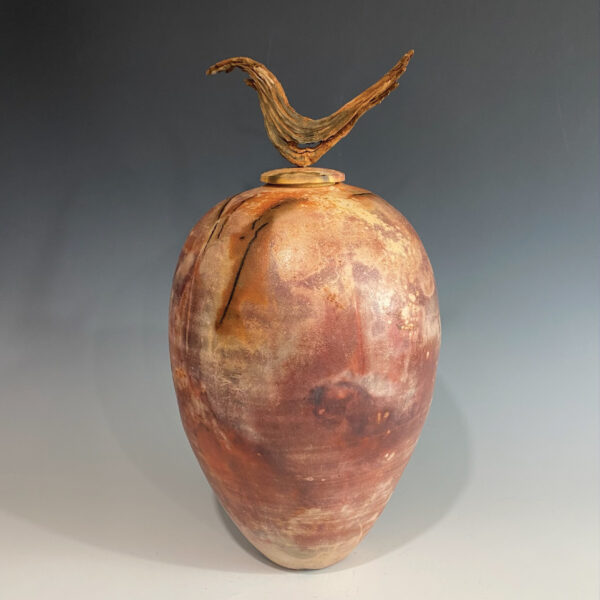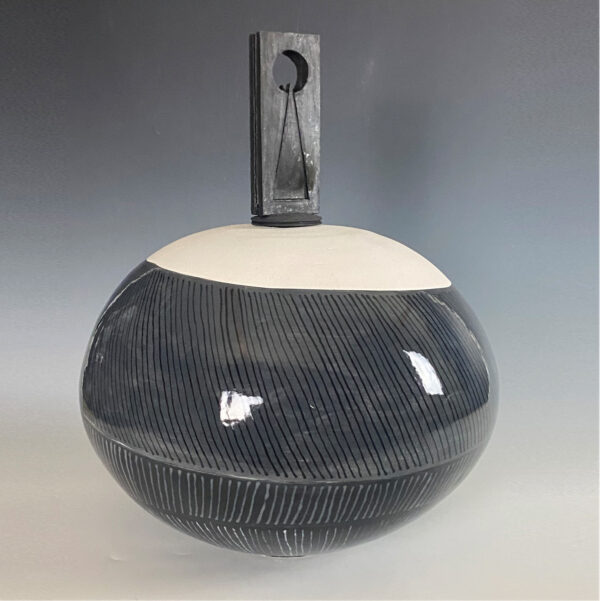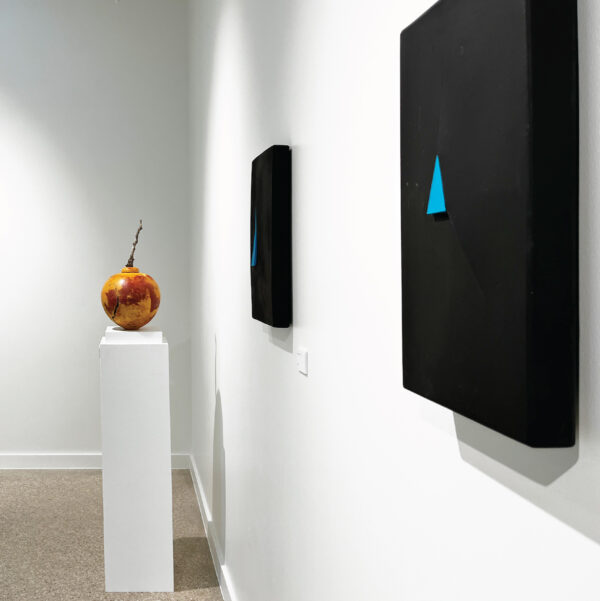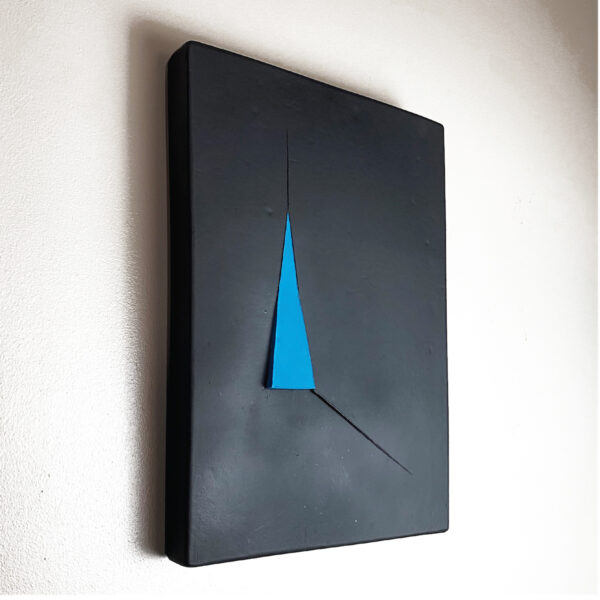As a high school senior in 1967, Winston Taylor won the General Motors Craftsman Guild award for his automobile designs. Then, after a nine-year career in auto body repair, Taylor discovered his true passion in a pottery class at the University of Arkansas Little Rock. He has since maintained his ceramic practice in Russellville, Arkansas, and was named an Arkansas Living Treasure by the Arkansas Department of Heritage in 2011. Taylor’s clay works have been extensively displayed across his home state of Arkansas and are highly sought after. Contemporary Clay, which is currently on display at the Rockport Center for the Arts, is his first exhibition in Texas.
After a successful opening weekend in January, Taylor talked with Glasstire about the various methods, techniques, and inspirations that are exemplified by his works featured in the exhibition. Contemporary Clay is on view at through February 26, 2023 in the Art Center’s McKelvey Charitable Fund Gallery.

Winston Taylor’s exhibition “Contemporary Clay,” on view at the Rockport Center for the Arts. Photo courtesy of the Rockport Center for the Arts.
Glasstire (GT): Do you notice any overlap between your clay practice and your previous work in auto body repair?
Winston Taylor (WT): Yes, there are similarities. Some of my skills in auto repair carried over into the techniques I use in ceramics to visually express my admiration for architecture and the natural environment.
GT: Can you describe some of these techniques?
WT: Besides just changing parts, there is sculpting required in repairing damage to an automobile, and there is a body filler that is similar in consistency to clay which acts as a surface smoother. I use some of the techniques required to assemble a car in making molds for my clay pieces, and I actually still use tools from the body shop in my ceramic studio, like paint sprayers, sanders, and grinders.
GT: You often use the raku method in your practice. Can you explain that process?
WT: Raku has become a lot more popular in the last several years. It entails using a suitable clay that is more porous and textural so it can absorb thermal shock. After the clay has dried, the piece goes through its first firing. Then, the glazes are applied to the piece and it undergoes a second firing. This is where the raku process differs — the second firing is the glaze firing, then it undergoes a third firing, the finish firing.
The finish firing is done in a propane kiln, and it’s heated very quickly to about 1,800 degrees. The kiln is open, so a lot of protective gear is required because it is glowing hot. The piece is placed among combustible material and there’s a short smoking period, and then it’s finished. For someone like myself who likes quick results, it’s fun.
One of the things I love about raku is that you’re involved in the whole process from start to finish, as opposed to more traditional techniques in which you make a piece, glaze it, then fire it in a closed kiln for hours. I also use those techniques, but I like Raku because even after 50 years of making pottery, I’m still enchanted by the results and I want to see them as quickly as I can.
GT: So while the Raku process yields faster results, it also requires you to be continually attentive to each step?
WT: Yes. All pottery has a sense of spontaneity in that you won’t know what it will look like until it’s done, but raku is a lot more unpredictable and surprising. You have to learn to use a lot of control in crafting the piece, but then you need to be able to let go during firing and accept what happens. I have enough experience that I can fairly predict results, but spontaneity and uncontrollability are always fun challenges for me.

A ceramic sculpture on view in Winston Taylor’s exhibition “Contemporary Clay,” on view at the Rockport Center for the Arts. Photo courtesy of the Rockport Center for the Arts.
GT: Where do you find inspiration for your pieces’ forms?
WT: When I took my first pottery class at the University of Arkansas at Little Rock, I was enamored with the potter’s wheel. Of course, while using the wheel is a form of sculpting, because you’re using a tool to form the clay, I didn’t really venture into sculpting on the workbench until a few years later. Now I enjoy hand building, which I regard as true sculpture, and I also still use the potter’s wheel because I still love that — I kind of combine the two techniques. My inspiration comes from architectural forms, machinery, and mechanical forms. Sometimes while looking at my pottery I’ll see something like a bridge or other structures, mainly in the top sections of my works.
GT: Do you reference any cultural traditions in your practice?
WT: Oh, yes. Years ago I became acquainted with the Native American artist Maria Martinez. She exclusively made these beautiful black-on-black pieces using both matte and glossy finishes. I became very interested in her process, and I actually took a workshop from one of her nieces, Adelphia Martinez, in Colorado. I stayed there for a week making black-on-black pottery, and I loved it. These pieces are actually made with red clay which then turns black. It’s amazing, really. The pieces are meticulously burnished to achieve that glossy finish, and fired in an intense smoking atmosphere, which makes them black. I use the same polishing and burnishing techniques in many of my pieces.

A ceramic sculpture on view in Winston Taylor’s exhibition “Contemporary Clay,” on view at the Rockport Center for the Arts. Photo courtesy of the Rockport Center for the Arts.
GT: What does the burnishing process entail?
WT: Once you start burnishing you can’t stop because you’re working on moistened clay, and it could dry out before you finish if you don’t keep going. For example, a pot that is ten inches in diameter would take about 45 minutes to burnish. To burnish, you rub a stone in strokes around the piece in one direction, then you come back in the opposite direction, rubbing the stone perpendicular to the direction of the first pass, and then maybe even a third time in a diagonal direction. It’s like drawing — the more you crosshatch, the more enhanced the color is. Burnishing achieves a completely smooth surface, and any areas left unburnished will turn matte.
GT: What do you find most fulfilling about your practice?
WT: The burnished pieces. There’s a technique that I also use often called saggar firing, which makes natural-colored matte finishes, mostly oranges and reds. Those results are pretty spontaneous with limited control, and the process also involves a raku kiln. I have several saggar pieces included in Contemporary Clay. Also, my daughter is an interior designer and I’ve collaborated with her firm on a few projects making concrete sinks and fireplace tiles.

Winston Taylor’s exhibition “Contemporary Clay,” on view at the Rockport Center for the Arts. Photo courtesy of the Rockport Center for the Arts.
GT: Did you create the pieces on display in Rockport specifically for Contemporary Clay?
WT: Yes, the pieces featured in Contemporary Clay were created expressly with Rockport in mind. When the Rockport Center for the Arts contacted me, I didn’t have anything available to show. During the last two to three years that we’ve lived through, I, like many artists, just hadn’t felt motivated. So when Rockport called me, it encouraged me to get in the studio and get busy. The design wasn’t influenced, because I used the same methods in these pieces that I’ve used for years, but the wall-installed works are new, and those were made especially for Rockport. I’m so thankful to them for calling me, and I’m looking forward to coming back.

A wall-hanging ceramic sculpture on view in Winston Taylor’s exhibition “Contemporary Clay,” on view at the Rockport Center for the Arts. Photo courtesy of the Rockport Center for the Arts.
Winston Taylor: Contemporary Clay is on view in the McKelvey Charitable Fund Gallery at the Rockport Center for the Arts through February 27, 2023.
This interview has been edited for length and clarity.


